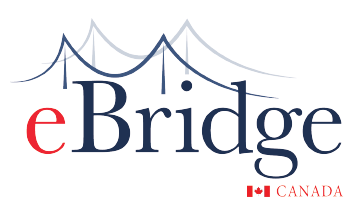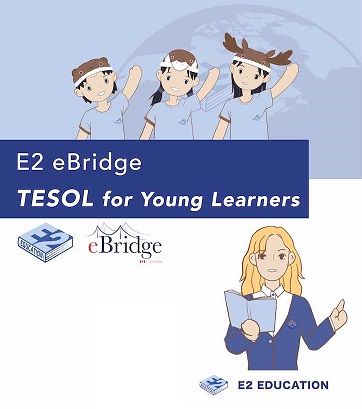Requirements
- College Diploma or Certificate - English Speaking Schools
- University Graduate with IELTS 5.5 or above - Non English Speaking Schools
- College Diploma with English Major - Non English Speaking Schools
- ESL teachers with more 2 years experience
- Candidate must meet one of above minimum requirement
Features
- Flexible schedule
- Comprehensive Program with complete support
- eBridge Textbooks and supporting materials
- Video and Audio instructions
Target audiences
- All qualified candidates who wish to join E2 eBridge team and become a TESOL teacher
EIEP provides teacher certification for those who want to progress in their educational careers through the E2 eBridge TESOL program for young learners. This TESOL program for young learners is an English training program of 160 hours that is split between 120 hours of online classes and 40 hours of practicum. Upon successful completion, the participant will receive the teacher’s certificate from EIEP.
This is complete version of E2 eBridge TESOL course.
Course Features
- Lectures 56
- Quizzes 8
- Duration 160 hours (120 + 40)
- Language English
- Students 12
- Certificate No
- Assessments Self
-
Module 1: Teaching Young Learners
Teaching English to young learners has become an on-demand job globally. In this module, we hope to bring to light a deeper understanding of who young learners are and how to productively teach and motivate them. At first, it may seem daunting to teach a class of young children, but having knowledge on who the young learners are and what helps them grow will hopefully put your mind at ease.
-
Module 2: Aims and Outcomes
In this module, we will go over some of the attributes of what it means to be an English teacher to young learners. This is essential in order for the students to get the most out of their learning and also, it allows the teacher to keep themselves at a standard in which they can always work towards. This age group may not be the easiest students to teach, but some may argue it is the most rewarding.
-
Module 3: Grammar
Grammar in the classroom is of course a very important component in teaching English. Since we are focusing on young learners it is essential that the teacher knows at least the basics of English grammar as it is foundational in the English language.
-
Module 4: Language skills: Speaking/Listening
There are four skills that are needed for communicating effectively in a language and also to have a deeper understanding of the language. These skills are listening, oral production or speaking, reading, and writing.
- 4.1 Language skills in the young learners classroom
- 4.2 Understanding speaking skills for young learners
- 4.3 Sounding out words
- 4.4 Reading out loud (activity for speaking skills)
- 4.5 Understanding listening skills for young learners
- 4.6 Using the eBridge videos for developing speaking and listening skills
- 4.7 Methods to help young learners’ become proficient in speaking and listening in English
- Quiz
-
Module 5: Language skills: Reading/Writing
We covered the speaking and listening skills in the previous module and now we will move on to the next two language skills, reading and writing. When it comes to these skills, young learners need to work a little bit harder as fine motor skills are required.
- 5.1 Understanding the reading and writing skills in young learners
- 5.2.1 Why is reading important in order to learn English
- 5.2.2 Beginning to read
- 5.2.3 Promoting an understanding of a text
- 5.2.4 Teaching vocabulary
- 5.2.5 Forming associations
- 5.2.6 Decoding
- 5.3.1 How to teach the writing skill to young learners
- 5.3.2 Sentence structure
- 5.3.3 Writing activities
- 5.4 Incorporating the language skills in lessons
- Quiz
-
Module 6: Lesson Planning
A lesson plan is helpful in that you can organize your thoughts and be clear about what you want your students to learn or understand. It’s hard to be organized during class when you are trying to get students to listen.
-
Module 7: Activities
In Module 1, we touched a little bit on activities. Now we will unpack classroom activities even more. We will look at some examples of activities you can do and how you can implement activities within different age groups.
- 7.1 Stirrers and Settlers
- 7.2 Vary your activities with the E2 eBridge Book Series
- 7.3 Utilizing activities in the young learners classroom: 4-6 year olds
- 7.4 Utilizing activities in the young learners classroom: 7-9 years old
- 7.5 Activities to strengthen new vocabulary
- 7.6 Utilizing activities intentionally
- Quiz
-
Module 8: Classroom Management
Let’s first address what classroom management is. Classroom management can be seen as things teachers can implement that create a classroom environment that is positive and where effective teaching and learning can happen.
- 8.1 Classroom Management Topics: Organization and Preparation
- 8.2 Classroom Management Topics: Punctuality
- 8.3 Classroom Management Topics: Instruction
- 8.4 Classroom Management Topics: Communication
- 8.5 Discipline in the young learners classroom
- 8.6 Accountability
- 8.7 Choosing your battles
- 8.8 Organize seating arrangements
- 8.9 Unique strategies
- Quiz

